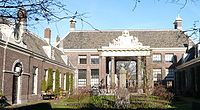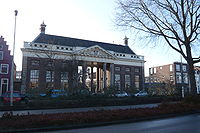
Teylers Hofje
Encyclopedia

The Teylershofje is a hofje
Hofje
A hofje is a Dutch word for a courtyard with almshouses around it. They have existed since the Middle Ages.A hofje provided housing for elderly people . They were privately funded, and served as a form of social security...
in Haarlem
Haarlem
Haarlem is a municipality and a city in the Netherlands. It is the capital of the province of North Holland, the northern half of Holland, which at one time was the most powerful of the seven provinces of the Dutch Republic...
, Netherlands
Netherlands
The Netherlands is a constituent country of the Kingdom of the Netherlands, located mainly in North-West Europe and with several islands in the Caribbean. Mainland Netherlands borders the North Sea to the north and west, Belgium to the south, and Germany to the east, and shares maritime borders...
with 24 houses.
History of the foundation


Pieter Teyler van der Hulst
Pieter Teyler van der Hulst was a wealthy Dutch Mennonite merchant, who died childless, leaving a legacy of two million florins to the pursuit of religion, arts and science in his hometown, that led to the formation of Teyler's Museum. This was not the value of his entire estate...
, just like the Teylers Museum
Teylers Museum
Teyler's Museum , located in Haarlem, is the oldest museum in the Netherlands. The museum is in the former home of Pieter Teyler van der Hulst . He was a wealthy cloth merchant and Amsterdam banker of Scottish descent, who bequeathed his fortune for the advancement of religion, art and science...
close to it. Pieter Teyler van der Hulst originally founded a hofje when his wife died in 1752 and he then purchased the Kolder hofje
Vrouwe- en Antonie Gasthuys
The Vrouwe- en Antonie Gasthuis is a hofje in Haarlem, Netherlands.-Foundation:This hofje is run by a foundation called 'Vrouwe- en Antonie Gasthuis', which was founded in 1440 as a guest house for pilgrims seeking shelter...
. That hofje was considerably renovated during his lifetime, but he found it still needed improvements for the residents. In his will he stipulated that a new hofje should be built in his name and the old hofje premises sold (and the premises were then sold to the oldest surviving hofje foundation in Haarlem, the 'Vrouwe- en Antonie Gasthuys'). The "new" hofje is by far the most impressive and imposing hofje in Haarlem.
Stylish location
In Teylers's day, most visitors to the city of Haarlem from Amsterdam would travel by trekschuitTrekschuit
Trekschuit, literal translation 'tugboat', is an old style of horse-drawn boat specific to the Netherlands where it was used for centuries as a means of passenger traffic between cities along trekvaarten, or tow-canals.-History:...
along the 'Stadsbuiten' canal (now the Papentorenvest street) joining the Spaarne
Spaarne
The Spaarne is a river, in North Holland, Netherlands. This partially canalized river connects the Ringvaart to a side branch of the North Sea Canal. It runs through Haarlem, Heemstede, and Spaarndam....
just north of this hofje. The first building they would see across the Spaarne was the immense classical building of the Catholic
Catholic
The word catholic comes from the Greek phrase , meaning "on the whole," "according to the whole" or "in general", and is a combination of the Greek words meaning "about" and meaning "whole"...
Diocese
Diocese
A diocese is the district or see under the supervision of a bishop. It is divided into parishes.An archdiocese is more significant than a diocese. An archdiocese is presided over by an archbishop whose see may have or had importance due to size or historical significance...
(now the Police station). Next they would pass the location of this hofje, and further around the bend, the Damstraat, where Teyler's house is located. His museum, which is located in the back garden of his house, competed with the Dutch Society of Science for scientific research.
Mennonites vs Catholics
It would have been Teyler's express wish to have his hofje located on the Spaarne, in the same way that the executors of his will defining the Teyler's Museum chose later to build a new front entrance facing the Spaarne and leading visitors to the side entrance of the 'oval room'. The hall of the Diocese, which was used for meetings of the 'Economical branch of the Dutch Society for Science', would have impressed Teyler. It took several years to build the Catholic Diocese, from 1760 to 1772, and Pieter Teyler van der Hulst would have attended the meetings there as a member, but he could not become a board member due to his religion. He was a MennoniteMennonite
The Mennonites are a group of Christian Anabaptist denominations named after the Frisian Menno Simons , who, through his writings, articulated and thereby formalized the teachings of earlier Swiss founders...
. In order to get around this, he founded his own 'society of science', which later became the Teylers Museum. Ironically, both his museum and the Dutch Society of Science are now across from each other on the Spaarne and were merged in 1831.
Architecture
This hofje was built by the popular contemporary architect Leendert Viervant, who designed several other neo-classicalNeoclassical architecture
Neoclassical architecture was an architectural style produced by the neoclassical movement that began in the mid-18th century, manifested both in its details as a reaction against the Rococo style of naturalistic ornament, and in its architectural formulas as an outgrowth of some classicizing...
objects in the 1780s in Haarlem. The hofje has a neo-classical facade and the doorway is flanked by Doric columns
Doric order
The Doric order was one of the three orders or organizational systems of ancient Greek or classical architecture; the other two canonical orders were the Ionic and the Corinthian.-History:...
.
Address: Koudenhorn 64

